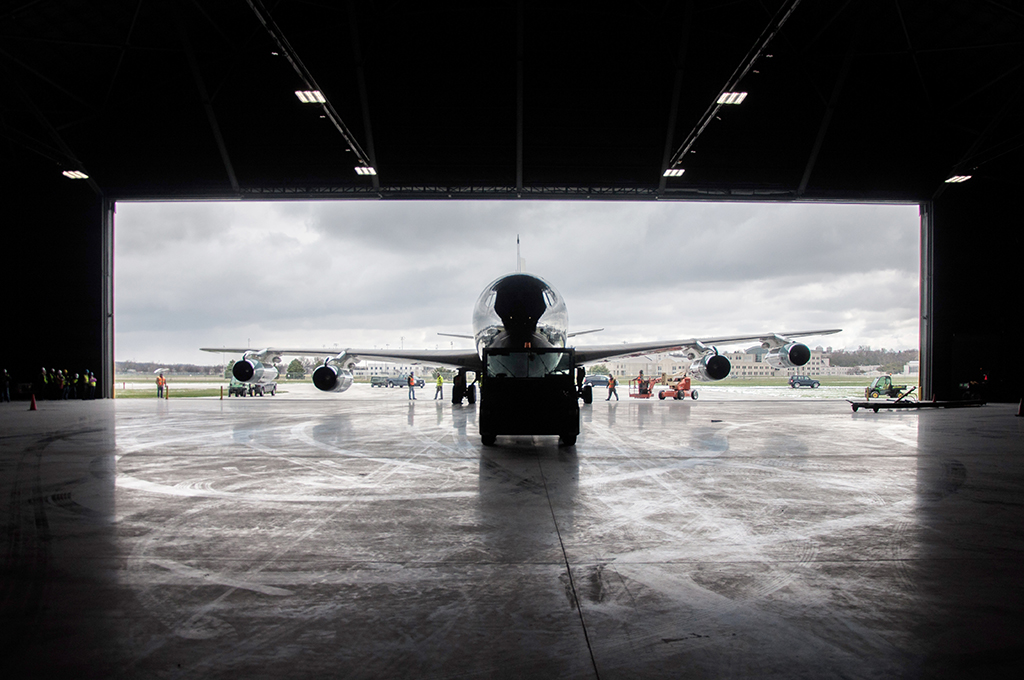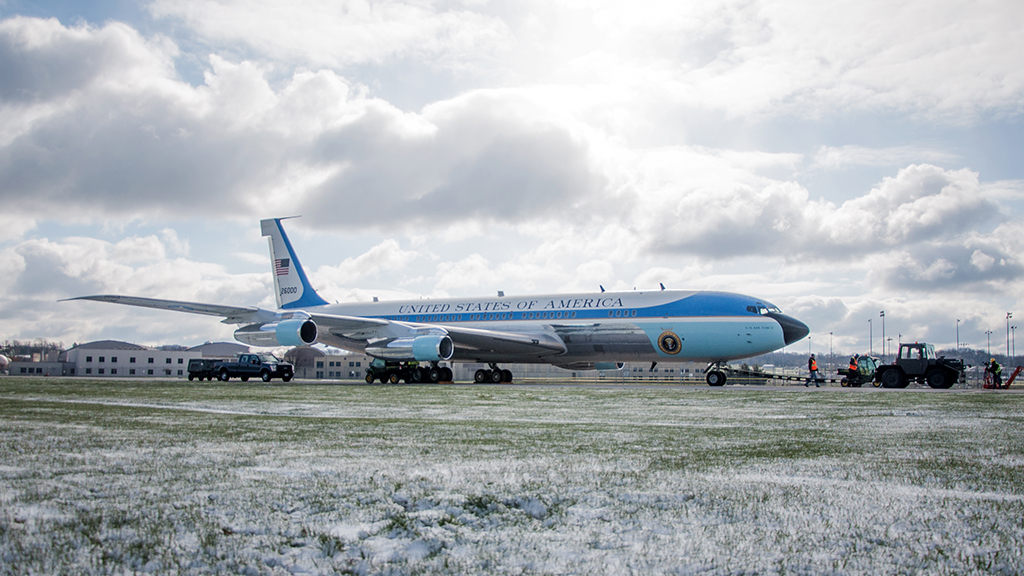This past Saturday, I was invited to attend a once in a lifetime event at the National Museum of the U. S. Air Force. After two years of building and planning, the Presidential Collection would be moving from a remote hanger on the grounds to a new permanent home in what is commonly referred to as Building 4.
Preparations for the move began days in advance. Volunteers and employees spent countless hours shining up the aircraft and prepping them for the ride down the flight line to their new home.
The Douglas VC-54C Skymaster which was the first aircraft built specifically to fly the President of the United States became known as “The Flying White House”. Because the aircraft was part of such high security during the Franklin D. Roosevelt presidency, it earned the nickname Sacred Cow. Museum Historian Dr. Jeff Underwood explained that one of the most unique aspects of the plane was the addition in 1945 of a battery powered elevator which allowed FDR to enter the craft easily in his wheelchair.
As we waited for the arrival of the Sacred Cow, Underwood shared many stories of the importance of this acquisition for the museum. By restoring the aircraft and adding it to the public display in the new building, it will allow the million or so visitors to experience a bit of American history and teach a new generation about a time gone by in aviation as well as national history.
As the aircraft made its way toward the building, the ground crew responsible for placing the plane inside the hanger maneuvered the aircraft as easily as you drive into a parking space at the local grocery store. The plane had to be turned to make the shorter trip down the tarmac to the entrance to the building where it will be on display for many years to come. The plan was to back the plane into the building through the largest of the doors within the museum complex. Watching as the tow pushed the nose of the plane while another crew member spotted the move from under the tail was amazing. The planning and precision was unprecedented as the plane simply glided into place just feet away from the Lockheed C-141 Hanoi Taxi. This was the aircraft which airlifted the first American prisoners of war out of North Vietnam in February 1973. Standing alongside Sr MSgt Retired Danny Bowen, he explained that the C-141 was the first aircraft that he serviced as a member of the U. S. Air Force back in the day. He told stories of how the tail section has a stairway that was used by mechanics for maintenance of the plane.
The Sacred Cow was also used by President Harry S. Truman for the first 27 months of his time in office. On July 26, 1947, Truman signed the National Security Act of 1947 while on board this aircraft. This act is significant to the history of the final home of the aircraft as it established the U. S. Air Force as an independent service.
Once the Eisenhower plane was in place, the giant doors were closed while we waited for the SAM 26000 otherwise known as the Boeing VC-137C which was the first aircraft built specifically for use by the President of the United States. Bowen served as the crew chief for this aircraft from 1981 until 1990.
Spending time with Underwood and Bowen as the planes were maneuvered into position was like a walk down memory lane. Underwood spoke about the memories that will be available to those with an imagination as they tour the SAM 26000 later this summer. The aircraft which transported eight sitting presidents during its flying career including President Richard M. Nixon on the first flight to China evoked images of Nixon standing in the doorway waving to the crowds. Underwood noted that visitors will be able to imagine standing at the top of the stairs looking out on a crowd at the airport.
He spoke about that sunny day in Dallas when President John F. Kennedy and First Lady Jackie Kennedy emerged to welcoming crowds in Texas. Later this same aircraft was to transport the slain president’s casket with his grieving widow back to Washington. Hudson and Bowen explained that crews had to remove a wall at the back of the plane and three rows of seats in order for the color guard to raise the casket up the stairs and make a turn to the left where a galley once stood. Later the wall was restored but modified for future needs.
Bowman served as crew chief during the Reagan, George H. W. Bush and part of the Clinton administrations. Over the years he traveled to 46 countries and 26 states with the SAM. He fondly recalled that the maintenance crew did not fly on board the SAM because of their numbers. As the time went by he did take a ride that he will always remember on the SAM with President Bush to Helsinki, Finland. One of his favorite stops was New Zealand.
Over the years Bowman collected items from the aircraft including his original light blue uniform which was worn by all of the crew. Later the color was changed to dark blue and he laughingly said his wife suggested that it was high time to reduce his collection. Bowman donated the uniforms along with an engine cover, matches, playing cards and probably most significant are the “trip books” that he has donated to the museum for their displays. Bowman described the books as something that was given to those on board which outlined where they would be traveling. He noted that they were left behind upon the end of the trip and if not picked up, they became part of the trash dump. Bowman may not have known at the time that he was picking up small bits of history, but the museum was definitely excited to have this as part of their collection.
As we waited for the crews to move the SAM into the building, you could see how moved Bowman was by the experience. He shared photos of his wife and sons in front of the aircraft. He also shared a photo of his crew from back in the early days.
The SAM was a little more of a challenge for the largest doors on the grounds due to the height of the tail. Crews lowered the plane by releasing air from the struts to allow for clearance. This maneuver was carefully watched by another member of the team who was on a scissor lift at the opening checking for the perfect clearance.
As we stood there watching the aircraft approach the building you felt a sense of reverence associated with a visit to the monuments in our nation’s capital. To think that this plane and the crew was responsible for the safety of the leader of the free world for 36 years for more than 13,000 flying hours. The images from the national news when President Lyndon B. Johnson took the oath of office on board came to mind.
In September of 1971, President Nixon flew on the aircraft to Wright Patterson AFB to attend the dedication of the first museum building. In December of 1972, this aircraft became the “backup” when a Boeing VC-137C (SAM 27000) was acquired by the Air Force. The plane continued to fly presidents, vice-presidents and other high-ranking government officials on important missions.
When the 26000 was used for transporting heads of state, diplomats, dignitaries and officials for historic journeys, it was known for Special Air Missions (SAM).
Bowman who now lives in Indianapolis admits that he will be back to see his working home once the displays are completed and open to the public, When asked about his thoughts regarding the new display he said “it is great to be able to see it” as part of the museum. He went on to say that he was pleased to “see the airplane that I worked on for so many years”. Bowman spoke about how the crew would begin on one side of the massive plane and shine the silver taking an entire day. The following day they polished and shined the other side. When asked about how the light blue paint was maintained, he noted that only so many touch ups could be done. He was privileged to see the aircraft stripped down and repainted during his service. The outside of the aircraft has been restored to the Kennedy era along with the interior. Visitors will be able to walk through the plane; however the interior has been protected by glass panels.
 Following the move, Lt. Gen. Retired Jack Hudson the Director of the museum spoke to the media assembled for the event. He explained that before June, two additional presidential aircraft will be added to the new building. The Grand Opening weekend is planned for June 11 and 12 with at least 10,000 visitors expected to tour the new displays. Hudson said that he expects to see an increase in the visitors this year with the increase in display space. “This is a big day for the Air Force, the museum and the community” said Hudson of the move.
Following the move, Lt. Gen. Retired Jack Hudson the Director of the museum spoke to the media assembled for the event. He explained that before June, two additional presidential aircraft will be added to the new building. The Grand Opening weekend is planned for June 11 and 12 with at least 10,000 visitors expected to tour the new displays. Hudson said that he expects to see an increase in the visitors this year with the increase in display space. “This is a big day for the Air Force, the museum and the community” said Hudson of the move.
Curator for the new area is Brett Stolle. He explained that the 224,000 square foot building will house four galleries, Research & Development, Space, Global Reach and Presidential. There are three science, technology, engineering and mathematics (STEM) Learning Nodes as part of the design as well. The Nodes will be used by the museum to provide programming for all ages. Schools will be able to travel to the museum and use the Nodes for out of classroom experiences. The Air Force will also be using the Nodes for programming. Many of the features of the fourth building will be state of the art including the use of LED lighting for the displays.
When visitors tour the gallery later this summer, they will also be able to see the North American XB-70 Valkyrie. This is the only remaining aircraft of this design. It will be part of the Research & Development display. In the Space Gallery, visitors will be able to explore NASA’s first Crew Compartment Trainer (CCT-1) which is part of the Space Shuttle Exhibit. Viewing these aircraft from the second floor balcony was simply breathtaking.
When people say “it was the best day ever” you know that they must have had an awesome experience. My experience in meeting the gentlemen and awaiting the arrival of the historic aircraft was one of those times that you realize, “I am one of the luckiest people today”, to experience history in the making and to be able to just chat one on one with those who made it all possible was extraordinary.
You can learn more about the new fourth building by visiting the museum web site. The building will open on June 8, 2016.


